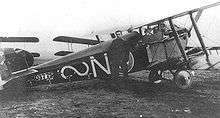No. 87 Squadron RAF
| No. 87 Squadron RAF | |
|---|---|
| Active |
1 September 1917 – 24 June 1919 15 March 1937 – 30 December 1946 1 January 1952 – 3 January 1961 |
| Country |
|
| Branch |
|
| Motto(s) |
Latin: Maximus me metuit ("The most powerful fear me") A "lazy S" mark, based on Wild West-style ranch branding, was the squadron's World War One identity marking early in its existence, this became a serpent in the badge.[1] |
| Insignia | |
| Squadron badge heraldry | A serpent reversed, head reguardant and tail embowed.[1] |
| Squadron Roundel |
 |
| Squadron codes |
PD Oct 1938 - Sep 1939 LK Sep 1939 - Dec 1946 B Jan 1952 - Jan 1961 |
No. 87 Squadron RAF was an aircraft squadron of the Royal Air Force during the First World War and Second World War.
World War I
87 Squadron Royal Flying Corps (RFC) was first formed on 1 September 1917 at Upavon from elements of the Central Flying School. On 17 December 1917, it moved to Hounslow Heath Aerodrome and was equipped with Sopwith Dolphins and S.E.5As, moving on to France in April 1918. After the armistice, the squadron moved back to England and was disbanded at RAF Ternhill on 24 June 1919.[2] The squadron did have seven aces on this type, in Arthur Vigers DFC, future Air Chief Marshal Leslie Hollinghurst, Henry Biziou, Joseph Callaghan (a commanding officer of 87 Squadron for a time, just achieving ace status with the Dolphin by war's end), Charles Darwin, Herbert Joseph Larkin, Alexander Pentland, and Charles Edward Worthington.[3]
World War II
87 Squadron was re-formed on 15 March 1937 at RAF Tangmere from elements of No. 54 Squadron RAF, operating the Hawker Fury. At the outbreak of the Second World War, the squadron was part of the air element of the British Expeditionary Force in France, equipped with Hawker Hurricanes.
The Cold War
87 Squadron was again re-formed as part of the 2nd Tactical Air Force in Germany on 1 January 1952 at RAF Wahn with the Gloster Meteor NF11, with the main tasking being the defence of the Ruhr, after five years it moved to RAF Bruggen, and was equipped with the Gloster Javelin as an all-weather interceptor force until it was disbanded on 3 January 1961.
Aircraft


| Dates | Aircraft | Variant | Notes |
|---|---|---|---|
| 1917–1919 | Sopwith Dolphin | Single-engined piston biplane fighter | |
| 1937-1937 | Hawker Fury | II | Single-engined piston biplane fighter |
| 1937–1938 | Gloster Gladiator | I | Single-engined piston biplane fighter |
| 1938–1942 | Hawker Hurricane | I | Single-engined piston monoplane fighter |
| 1941–1944 | Hawker Hurricane | IIC | |
| 1943–1944 | Supermarine Spitfire | IX, VB, VC VIII | Single-engined piston monoplane fighter |
| 1944–1946 | Supermarine Spitfire | IX | |
| 1952–1957 | Gloster Meteor | NF11 | Twin-engined jet night fighter |
| 1957–1961 | Gloster Javelin | FAW1 | Twin-engined jet fighter |
| 1958–1960 | Gloster Javelin | FAW5 | |
| 1959–1961 | Gloster Javelin | FAW4 |
Notes
- 1 2 "87 Squadron". Royal Air Force. Retrieved 26 January 2016.
- ↑ Halley (1988)
- ↑ http://www.theaerodrome.com/aircraft/gbritain/sopwith_dolphin.php?pageNum_aces=0&totalRows_aces=27#aces Retrieved on 10 June 2010.
- ↑ Jefford 1988, page 51
References
Bibliography
- The Illustrated Encyclopedia of Aircraft (Part Work 1982-1985). Orbis Publishing. 1985.
- Halley, James J. 1988. The Squadrons of the Royal Air Force & Commonwealth 1918-1988. Air Britain ISBN 0-85130-164-9.
- Jefford, C.G. (1988). RAF Squadrons. Airlife Publishing Ltd. ISBN 1-85310-053-6.
External links
| Wikimedia Commons has media related to No. 87 Squadron RAF. |